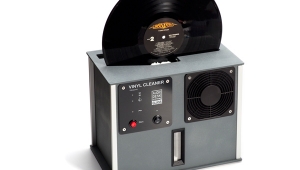| Columns Retired Columns & Blogs |
Sutherland Engineering Timeline record weight Manufacturer's Comment
Manufacturer's Comment
Editor: Thank you for introducing the Timeline. The Timeline is all about precision. Two things make that claim come true.
First is the accuracy of the time base. It is incredibly accurate—to within two parts per million. At that level, it must be considered that the resonant frequency of a crystal changes with temperature. Usually, time bases of that precision use a temperature-regulated oven to keep the crystal temperature constant. Instead, the Timeline circuitry takes a measurement of the crystal's temperature every 64 seconds. Using that information, it places an appropriate compensatory load on the crystal. Accuracy is maintained over a temperature range of 0° to +40°C.
The second issue is application of the achieved time-base precision. All that accuracy would be wasted if it were merely used to illuminate an ordinary strobe disc. The small radius of a strobe pattern makes slow drift hard to see. Also, everything is rotating, so it is hard to fix to a reference position. The Timeline is a literal expression of "outside the box" design. Timing marks are laser-projected from the rotating turntable into the room. Eight timing marks are projected every 1.8 seconds (for 33.33rpm). At least one of the marks will hit a distinctive feature of the room. Even the smallest speed error will be revealed as a drifting of the marker position.
The Timeline is machined using a four-axis CNC. The top is made of solid 6061 aluminum billet, brushed and anodized. The bottom is machined Delrin. Many listeners also use their Timeline to damp record vibrations. The Delrin couples well to the vinyl, and is then further constrained by attachment to the aluminum top section with nine socket-cap screws of stainless steel.
If you would like to see a Timeline in action, Jaime Monroy has produced a video clip of a Timeline at work. Just go to YouTube.com and search for Sutherland Engineering Timeline. Since that was made, there has been a software change to the Timeline. Instead of one flash per 1.8 seconds, there are now eight equally spaced flashes per 1.8 seconds. For each revolution, eight spots are projected. At least one of the eight will hit a good reference. Just watch for drift on that one and ignore the other seven. Makes it much easier to use.—Ron Sutherland. Sutherland Engineering
- Log in or register to post comments

























